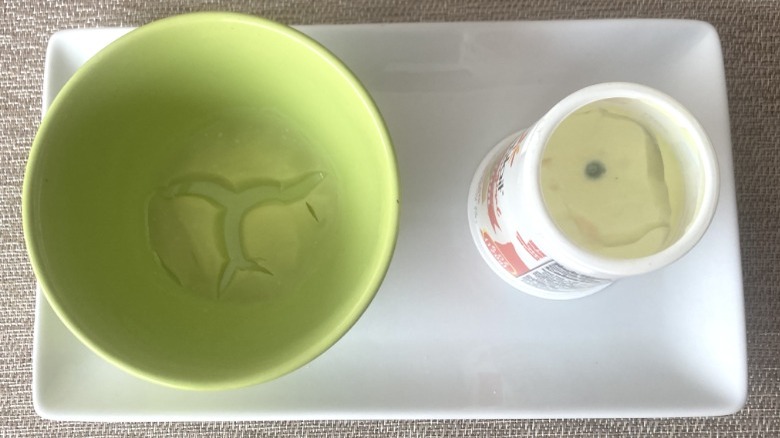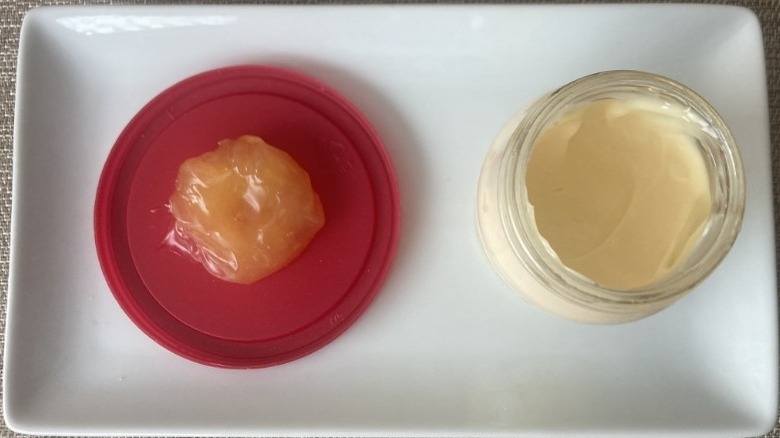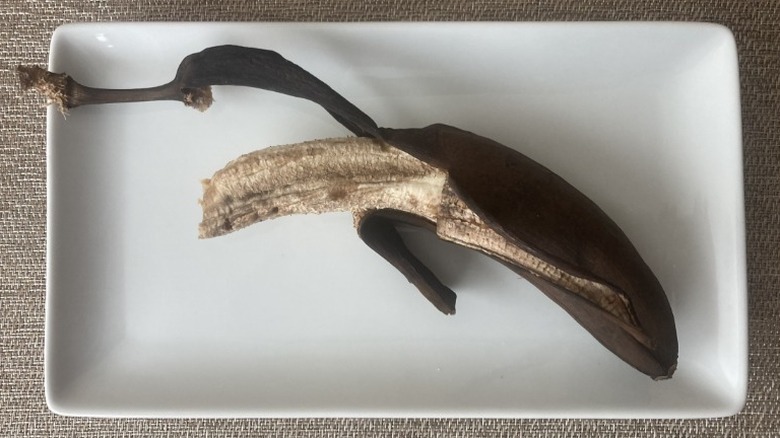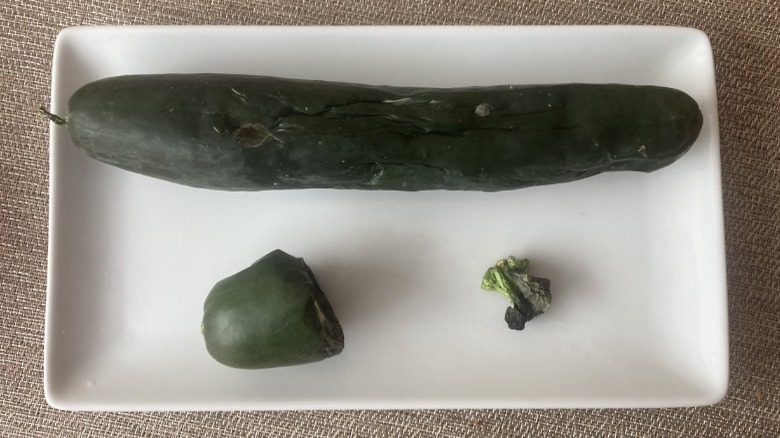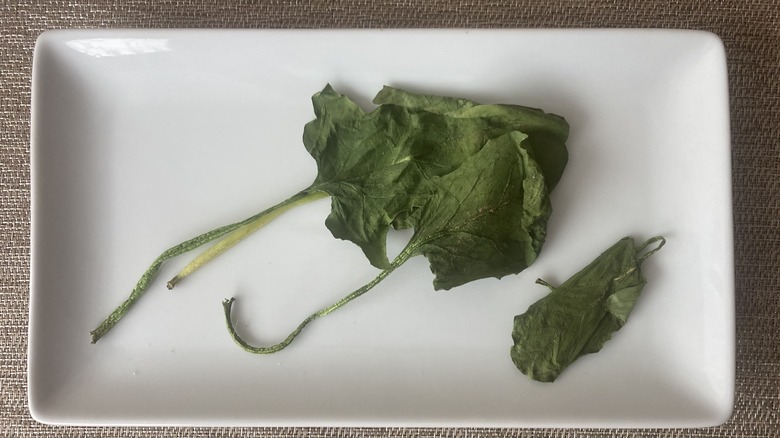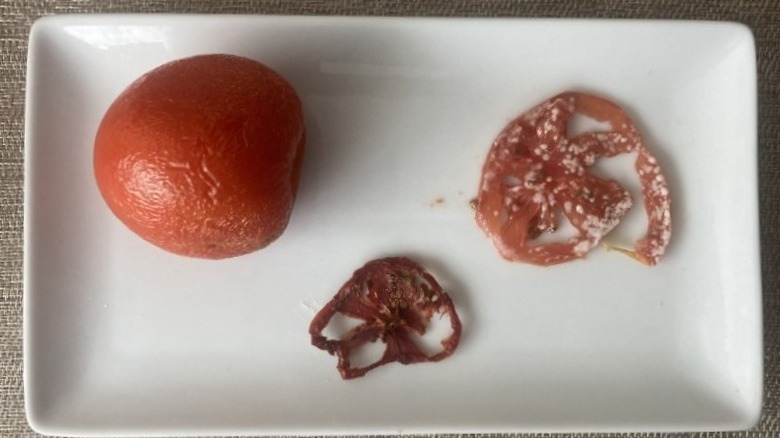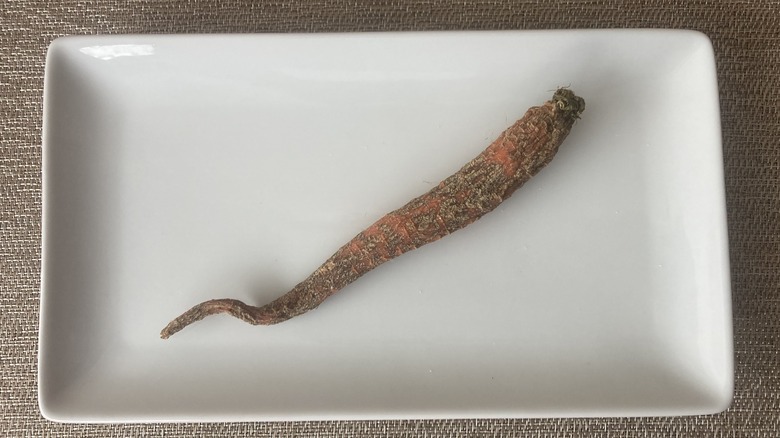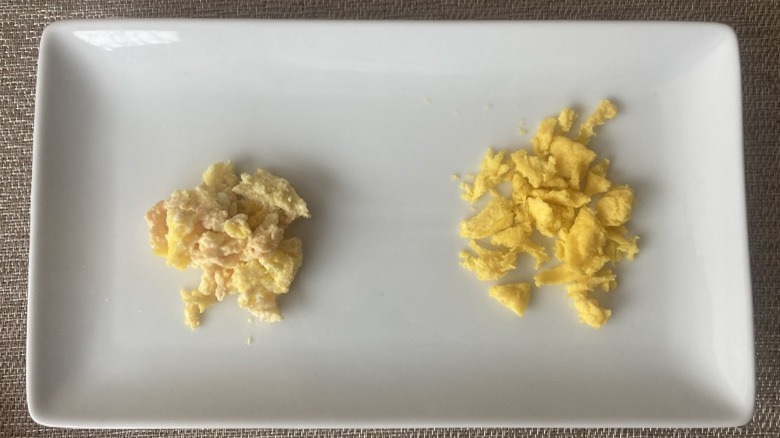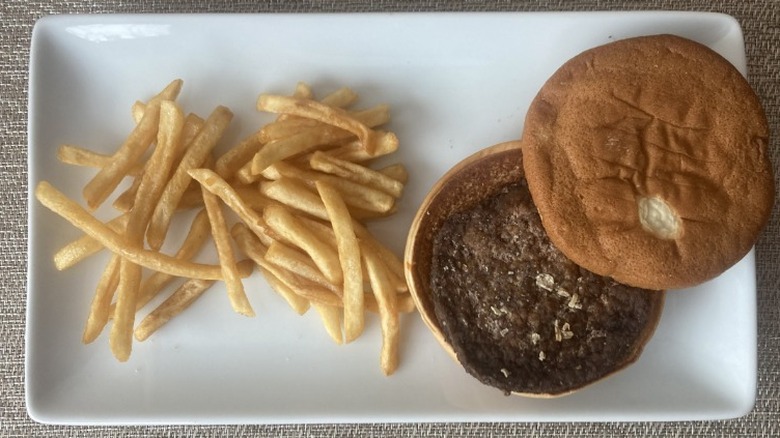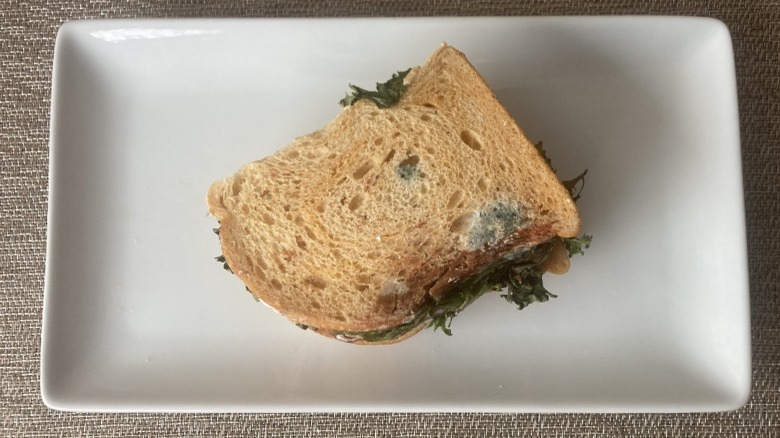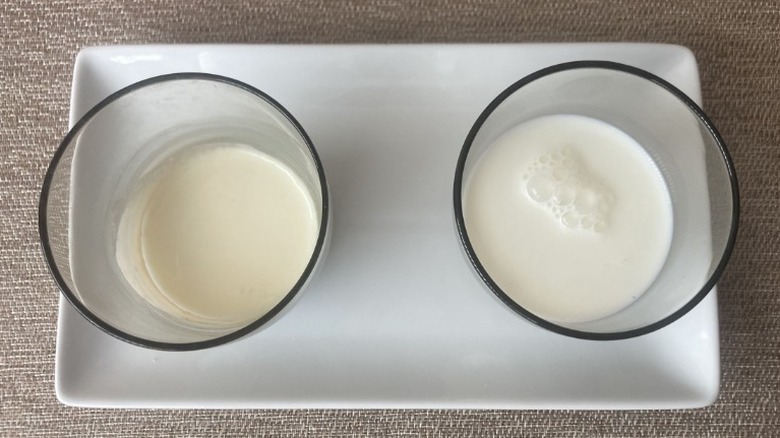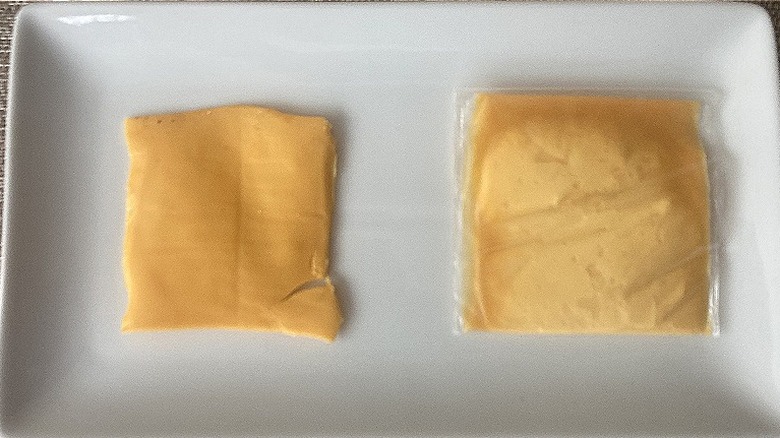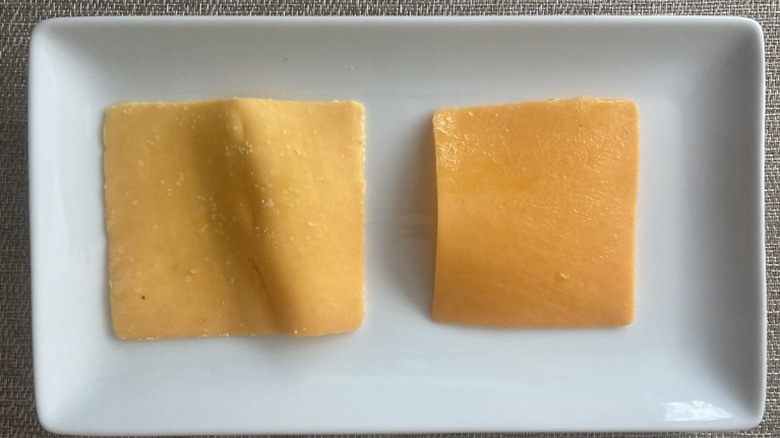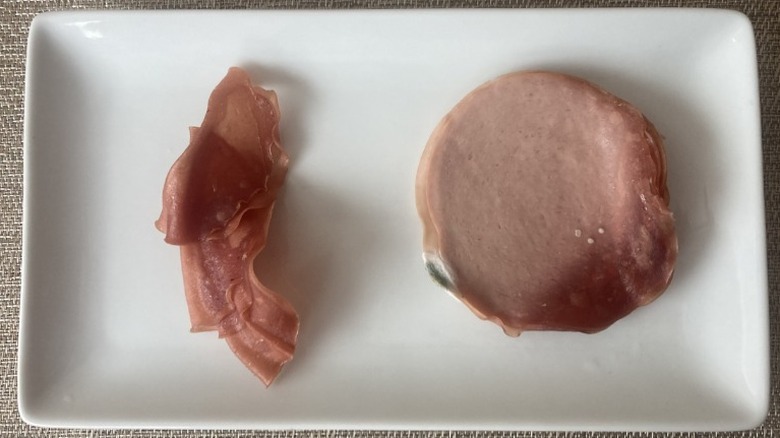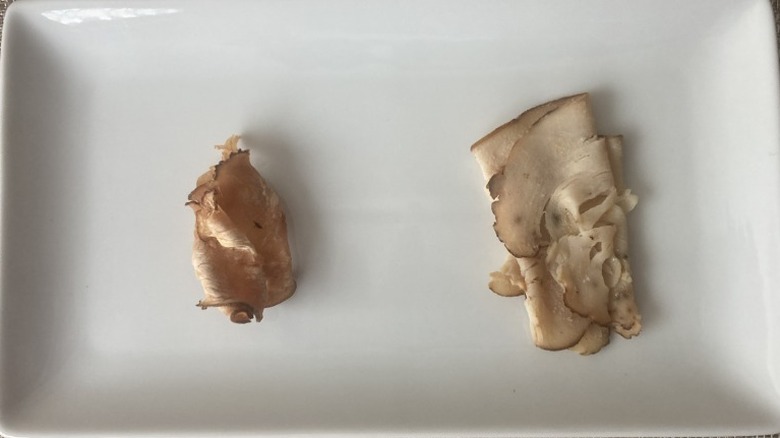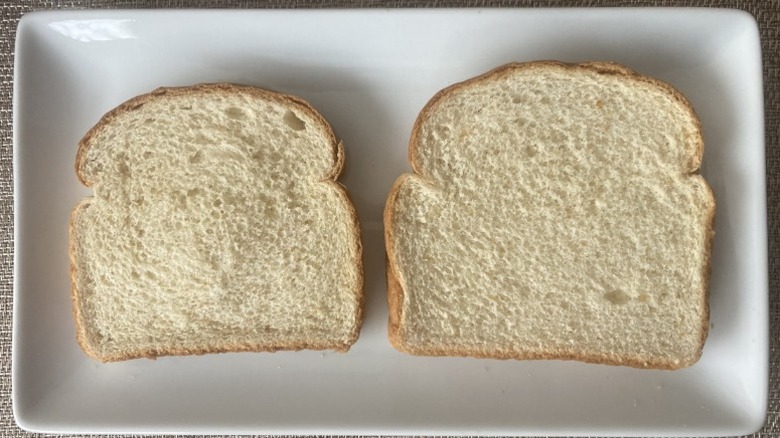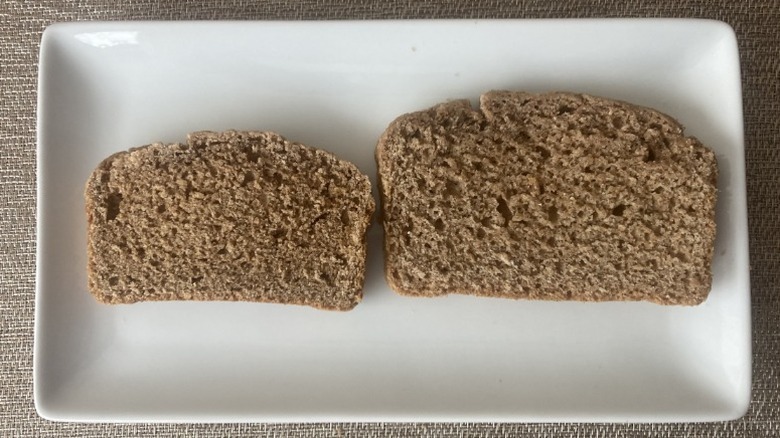What These Common Foods Look Like A Month After They Were Opened
Everyone with a kitchen has made the mistake of opening food, popping it in the fridge, and promptly forgetting about it for, oh ... maybe a month? Maybe more? Usually, the stench alerts you to its existence and its age. The farther it gets pushed to the back of the shelf, the longer it takes you to realize it's in there. When you finally haul it out, it's more than likely inedible, and quite possibly a health hazard. It usually gets pitched right in the garbage can without a second glance.
But what do these abandoned edibles actually look like when they hit the one-month mark? Is there a notable difference between food that's new and food that's been neglected for 30 days? For the sake of kitchen science — and a nagging curiosity that wouldn't go away — a lab was created in the form of a volunteer fridge and a slew of tasty bites were left unattended for one month. Photographic evidence was collected in an attempt to answer the question that has plagued mankind since the dawn of refrigeration: "What does fridge food look like a month after it's been opened?" The results aren't pretty, but they are pretty interesting.
Yoplait yogurt
A cup of Yoplait yogurt offered itself up as a sacrifice, in Key Lime flavor, to be precise. While pulling back the foil lid and leaving the cup open to the frosty fridge air is the most likely form an open yogurt would take, the experiment went a step further. A spoonful of yogurt was left in a bowl, similar to what a snacker might do if they were too full to finish but thought they'd finish it later.
Not surprisingly, the yogurt in the bowl lost its moisture and became a pale, cracking film. The yogurt in the cup kept much of its original texture but began developing potentially hazardous mold. Our expectation was for much more mold, considering the probiotic content of yogurt in general. Though the yogurt in the bowl no longer had a smell, the aroma of the yogurt cup remained intact, giving off a bright, if artificial and not entirely appetizing, lime scent.
Best Foods Real Mayonnaise
Unless it's feeding a large family, a jar of Best Foods Real Mayonnaise is slow to empty, which means it may sit in the fridge for at least a month. The name doesn't lie; with eggs, oil, and vinegar on the ingredients list, this mayo is really real.
For the experiment, the lid on the mayonnaise jar was left open to recreate a real-life "oh no" moment. A scoop was also plopped on a plastic tray to test what happens to unjarred mayonnaise after a month-long fridge exposure. While the jar suffered no notable changes and smelled as fresh as the day it was opened, the mayo on the tray underwent an amazing transformation. Exposure to a month of open air changed the mayo from a scoop of creamy white sandwich spread to a translucent blob that had the look and texture of Vaseline. The mess on the tray was tidy and interesting to look at while the mayonnaise in the jar appeared to be uninjured.
Banana
Bananas left in refrigerators seldom have a positive experience. Both age and exposure to cold turn the flesh and the skin brown. Being left in the open air doesn't help either, so there was no way bananas could be kept off the list. To mimic what might happen in a real situation, the banana was peeled and left for someone to remember it was there. In the real world, someone hungry for a banana would just peel a fresh one and forget about the cold one waiting in the fridge.
As expected, the banana browned up in a big way. The skin nearly blackened and shriveled considerably, while the flesh discolored to a strange brownish-grey hue Pantone won't be replicating anytime soon. Other bananas in the annals of our fridge forgetfulness have gone dry in addition to browning, but this one appears to have some life left in it yet. While a banana this ripe might be good for banana bread, this specimen is destined for the trash.
Cucumber
Cucumbers are largely water, a reality that makes them a squishy subject for a fridge experiment, both literally and figuratively. With such a high water content, would a cucumber left in a fridge for a month leak? Turn soggy and wilt? Dry up and blow away? The answer to all three questions is yes, depending on the state of the cucumber.
Because the average eater is equally likely to have whole and partly sliced cucumbers in their fridge, three different cucumber subjects were included in the experiment. Both a whole cucumber and a half cucumber were left in the crisper drawer, where fridge-bound cucumbers usually live, while another half cucumber was left out and about as a free-range cuke. The whole cucumber developed wrinkles and began to weep, while the half cucumber in the crisper shriveled and developed mold on its open surface. Meanwhile, the free-range half-cucumber disintegrated, curling up into a ball in an attempt to disappear. As it turns out, science isn't for everyone.
Spinach
Spinach also has a high water content, which makes it a likely candidate for evaporation and drying out when left in a fridge. For the experiment, a few leaves were left out in the open on a shelf, simulating a salad that had a few bites left. Some of the spinach dried to a crisp, while the rest retained much of its water while going limp instead. The stems entered the shriveling stage as of day 30, and these leaves wouldn't be an appealing or healthy option for anyone in search of a decent salad. But finding them still recognizably spinach-esque was a delightful surprise.
The results prompted the question: How long will it take in these conditions for spinach to become something other than itself? Will it ever become dry enough to crumble, or will it break down and liquefy if left long enough? The possibilities are mind-boggling.
Tomato
Tomatoes are a sticky wicket when it comes to fridge storage. Do they go in the fridge before they've been cut, or after? Once sliced, is it best to eat the tomato all once, or can you dip in and out as your sandwich or salad needs dictate? As it turns out, tomatoes in the fridge do not fare well for a 30-day stretch. Depending on how you store them, you can end up with a few different messes to contend with.
For the experiment, a whole tomato and a tomato slice were left on the shelf, while another slice was sealed in a plastic container. After a month, the whole tomato appears to have aged, pruning and softening as it surrendered. The tomato slice left uncovered dried up and shrank to less than half its original volume, taking on the appearance of a dead spider. But the tomato slice in the container was the most ambitious. That slice started its own mold colony, in what can only be seen as an attempt to take over the fridge entirely.
Carrot
Rather than testing baby carrots, kitchen science demanded the experiment test a carrot in its adult state. Though baby carrots are just big carrots cut down to size, the processing might have thrown the experiment a twist no one was ready to address. So a single carrot from the bulk section of the grocery store was drafted for the test instead, then chucked in the crisper drawer to see what would happen.
The carrot took on the appearance of a raisin, if raisins were made of carrots instead of grapes. It wrinkled and shrank while turning soft and developing some sort of crust. The possibility of peeling and cutting a carrot in this state is nil, rendering the month-old carrot inedible but also giving it the sympathetic charm of a geriatric earthworm slowly slipping into oblivion. If there's a heaven for root vegetables, this carrot is bound for glory.
Scrambled eggs
A half-eaten breakfast burrito is a prime candidate for hitting the fridge and being forgotten about in favor of waffles the next day and pancakes the day after that. To mimic discarded scrambled eggs left in cold storage, a scrambled egg was split in half and placed in both an open dish and a sealed container. How would each form of storage affect the eggs inside? The possibilities were tantalizing.
The eggs in the open dish did what most eggs left unattended would do: they dried up. Or, more accurately, the thinner bits dried up, while the larger pieces became rubbery. What happened to the eggs in the container was offensive to at least three physical senses. Popping the lid released a hideous odor that made the usual rotten egg smell seem like designer perfume by comparison. Rather than drying up, the eggs seemed to have leeched moisture, creating a film on the container. As expensive as eggs are, it's best to use them and not lose them rather than storing them for the future, only to find out your eggs are now toast.
McDonald's burger and fries
At some point, everyone has left a burger and some fries in their McDonald's bag and tossed them in the fridge for later. Anyone who remembers that it's in there knows the burger seizes up and the fries turn solid and leave a weird film on the roof of your mouth. The New York Post wrote about a McDonald's cheeseburger that looked the same after being left in the bag for 5 years. So what would your McDinner look like after the first few weeks? Would it be the least bit appetizing? How seized and solid would everything turn?
Pretty solid, as it turns out. The burger became the consistency of a hockey puck, while the bun lost any resemblance to the bread it once was. And while the fries surrendered most of their grease to their paper wrapper, they also became oddly glossy, as if somehow the grease had given birth to even more grease. Though the burger lost its pretty composition, aside from the grease stain, the fries remained quite photogenic. Kitchen science is full of surprises.
Panera Mediterranean Veggie Sandwich
Known for its fresh dining options, Panera seemed fair game for the 30-day fridge test. A Mediterranean veggie sandwich containing greens, onions, cucumbers, and feta cheese stepped up to the challenge, left in its wrapper and kept in the bag it was born in. How would fresh bread made with no preservatives fare? What about the moisture from the contents ... would that somehow soften the bread and cause it to dissolve? The lab fridge was quivering with anticipation.
The unwrapped sandwich showed instant evidence of its preservative-free state, with blossoming mold spreading on the crust. Though interesting to look at, bread mold is decidedly unhealthy to consume. The shriveled greens peeking out at the borders seemed to be trying to escape, which seemed odd until an attempt to open the sandwich revealed that the bread and fillings had fused. To separate the pieces would be to destroy the sandwich entirely. The moldy bread and terrified lettuce was proof enough that a month is an eternity in the life of fresh sandwiches.
Bar-S Bun Length Hot Dogs
With as many mysterious ingredients as hot dogs contain, including Bar-S Bun Length Hot Dogs in the experiment was a real roll of the dice. To replicate true-life food scenarios, the package was opened and two hot dogs were removed and left on a plate in the open fridge. The remaining hot dogs were left in their plastic and sealed in a zipper bag for storage.
It didn't take a full month for the open-fridge hot dogs to show signs of distress. But by the end of the 30 days, they had shrunken to half their original size, turning as hard as golf pencils in the process. The hot dogs in the bag kept their size and shape, but the stench released when the bag was opened spoke of bad times. The hot dogs inside had developed a slime, with some of the links oozing what appears to be solidified fat. Hot dogs aren't healthy on day one, and surviving in the fridge until day 30 does no one any favors.
Shamrock milk
The horrid surprise stink of opening a carton of old milk is a dark milestone in everyone's life. It's a food spoilage nightmare that no one ever gets used to, no matter how many times they experience it. So naturally, milk had to be part of the experiment. To give it a real-world twist, a small glass of Shamrock milk was left uncovered, while the remaining bottle was left with the cap loosened. Surely, there were disgusting moments coming as the month ended.
But ... no disgusting moment ever arrived. While the milk stored uncovered (left) evaporated a bit and left a fatty film on the glass, the milk in the bottle (right, poured into a glass for photo purposes) showed no sign of stench and no curdling. By no means does this mean the milk industry has gotten ahead of kitchen science, just that further investigation is warranted. Though it's pasteurized, the full bacteria content of the milk after 30 days is unknown, and there's no sense in taking a chance just because the bottle passes the smell test. The lab fridge is happy to remain stench-free, however.
Kraft American Singles
Food giant Kraft calls its Singles "cheese product" rather than "cheese." Despite not being named as such, the experiment treated this foodstuff as if it were, indeed, real cheese. What would happen if one slice were left open and one half-wrapped? Would there be a notable difference, or is non-cheese a 30-day survivor no matter how you store it?
As it happens, there is an incredibly notable difference. The half-wrapped cheese remained soft at its center, but its margins began to dry and darken, developing a crusty texture. This texture dramatically changed in the unwrapped slice, which became as solid as plastic. The unwrapped slice also shrank notably and developed a severe crack in one corner. Unlike many of the other test subjects, the unwrapped American slice also came with an audio component, emitting an audible clack! when placed on the photographing tray. This was mildly interesting musically, but thoroughly fascinating from a food consumption standpoint. The lesson should be to leave your cheese-ish product fully wrapped until you intend to use the whole slice.
Deli cheddar cheese
Deli-style cheddar cheese proudly declares itself to be real cheese, which seems to indicate different properties than processed cheese product. These properties were predicted by kitchen science to bring about different results at the 30-day mark. How distinct a difference would there be from what happens to American Singles?
To simulate true cheese storage scenarios, one slice of cheddar was left in a sealed bag for the duration of the experiment, while another was left out in the open. Cheddar cheese performed in a remarkably similar fashion to the American cheese product. The uncovered slice (right) shrank and hardened, buckling in the center and developing greasy beads on its surface. The slice sealed in the bag (left) developed a sickly odor, and though it retained its original size, it also developed the beginnings of white mold. So, while cheese-adjacent slices become weird after a month in the fridge, so does real cheese.
Carl Buddig turkey
Packaged lunch meat stored in a plastic bag like Carl Buddig turkey creates a relatively unnatural state for real food to be kept in. Using less than a full package means leaving the rest in this state even longer. With sodium nitrate and other preservatives present in these slices, what level of deterioration would occur in 30 days? For the sake of kitchen science, a slice of turkey was left in the open, emulating a leftover sandwich that may not have made it off the plate. The rest remained in its bag to see how much protection this sort of cover would offer. Kitchen science believed it would prevent the meat from drying out, at the very least.
Well, kitchen science was partly mistaken. The turkey left in the open (left) transformed past the state of jerky into some sort of crisp meat chip state. It clattered against the photographing tray, which is never a good sign for meat. But the meat in the bag fared only slightly better, with one edge experiencing the dry-out, while the rest experience a mold bloom destined to spread.
Boar's Head turkey
If lunch meat filled with preservatives turns into a crispy clump, fresh lunch meat like Boar's Head turkey must have a different experience chilling out for 30 days in the fridge, right? Kitchen science thought so. A single slice was left on a plate, exposed to the cold air, while the remaining slices stayed safe and sound in their zipper pouch. Would lunch meat from a fresher source perform more admirably, or succumb to the same tragic fate as the pre-packaged slices?
After a month in cold storage, the slice left in the bag (right) had become sweaty and began to stink, but was still recognizable as meat in color and texture, if not in aroma or appeal. The slice left in the open (left), however, had pulled a Carl Buddig and turned into a crusted meat knot that couldn't be pulled apart without breaking. It also played percussion when laid on the photography tray. As is true with other refrigerated meats, buying it fast and eating it quickly seems to be the best approach.
Wonder Bread
Wonder Bread is the gold standard when it comes to food that lasts. A slice of Wonder Bread in the fridge for 30 days would surely retain its form and color and even be a little appetizing, wouldn't it? Kitchen science voted a resounding "yes" while leaving one slice of Wonder Bread on a plate in the open fridge and sealing another slice in the original bag. If there was one food that could survive a month-long spell in the icebox, Wonder Bread was the prime candidate.
As the results and photographs show, it was ... and it wasn't. The slice stored in the open (left) shrank only slightly, pulling in its crusts in a presumed attempt to stay warm. The slice sealed in the bag (right) was just a bit larger than its chilly counterpart, but their textures couldn't be more different. The in-the-open slice turned stone-like in its hardness, with no give at all when pressed in the center. The slice from the bag, however, was ready to hit the toaster. Missing from both slices? Tell-tale signs of bread mold. Calcium propionate, a common preservative used in Wonder Bread, likely helps keep spore growth at bay.
Homemade beer bread
Sure, bread with a shelf life is bound to do well on a 30-day vacay in the fridge. But what about bread made from only whole wheat flour, baking powder, sugar, and beer? How would a humble home-baked loaf of beer bread fare against cold temperatures and dry conditions after a month in food jail? One slice stayed on a plate out in the open, while another slice went in a zipper bag for storage. Without preservatives, surely neither wouldn't last the duration.
For the most part, homemade beer bread did remarkably well in the experiment. The slice left in the open (left) shrank a bite while hardened thoroughly, but it retained its form and showed no signs of developing mold. The slice left in the bag (right) not only kept its size but also retained its texture and its softness. While the taste and safety of the slice from the bag were absolutely in question, it remained a familiar food form that looked like it could go another 30 days.

